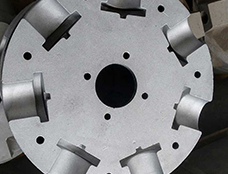+86 311 85258258
+86 311 85258258
Aug. 14, 2020
Cast aluminum molds are generally placed above a sealed crucible or holding furnace. Compressed air is introduced into the crucible or holding furnace, which creates a low pressure (0.06~0.15MPa) on the surface of the molten metal so that the aluminum liquid rises from the riser to fill up. Mold and casting method for controlled solidification.
Aluninium low pressure casting is a casting method that enables the liquid aluminum alloy to complete the filling of the aluminum mold cavity and solidification process under a relatively low pressure to obtain high-quality castings. Because of the low pressure (0.06~0.15MPa), it is called low-pressure casting.
The process is as follows: in a sealed crucible or holding furnace, dry compressed air is introduced, under the action of gas pressure, the aluminum alloy liquid enters the feed pipe along the riser pipe and rises, and enters the mold shape smoothly through the inner runner Cavity, and maintain the gas pressure on the liquid surface in the crucible or holding furnace until the aluminum casting is completely solidified and formed. Then the gas pressure on the aluminum liquid surface is released, and the unsolidified aluminum alloy liquid in the riser pipe flows back to the crucible or holding furnace, and the mold is opened and the casting is taken out. The basic characteristics of the low-pressure aluminum casting process: the filling speed and pressure can be adjusted appropriately. There are two types of casting molds for low-pressure aluminum casting: metallic and non-metallic. Metal molds are mostly used for large-scale and mass-produced aluminum castings, and non-metallic molds are mostly used for single-piece small-batch production. For example, sand molds, graphite molds, ceramic molds, and molten mold shells can all be used for low-pressure aluminum casting, and more used in production It's still a sand mold. However, the air permeability and strength of the sand molding material for low-pressure aluminum casting should be higher than that of gravity pouring. The gas in the cavity is exhausted by the exhaust duct and sand pores.
Aluminium investment casting companies, in order to make full use of low-pressure aluminum casting, the aluminum alloy feeds the castings from bottom to top under pressure. When designing the process, consider making the castings far away from the gate solidify first, Let the gate solidify last, so that the casting is fed through the gate during the solidification process to achieve sequential solidification.

Aluninium Low Pressure Casting
2. Unique advantages of low-pressure cast aluminum alloy:1). Aluminum alloy liquid filling is relatively stable;
2). The casting has good formability, which is conducive to the formation of castings with clear contours and smooth surface, without pores and sand holes.
3). The process yield of molten aluminum is improved. Under normal circumstances, a riser is not needed, so that the yield of molten metal is greatly improved, and the yield can generally reach 90%.
In addition, good working conditions; simple equipment, easy to realize mechanization and automation, are also outstanding advantages of low-pressure cast aluminum.
3. The low-pressure aluminum casting process
The process specifications of low-pressure cast aluminum include filling, pressurization, mold preheating temperature, pouring temperature, and mold coating.
(1) Filling and pressurizing
The rising liquid pressure refers to the required pressure when the aluminum alloy liquid level rises to the gate. The rising speed of the aluminum alloy liquid in the riser pipe should be as slow as possible, so as to facilitate the discharge of gas in the cavity, and also prevent the aluminum alloy liquid from splashing when it enters the gate.
(2) Filling pressure and filling speed
The filling pressure Pa refers to the pressure required to raise the aluminum alloy liquid filling to the top of the mold. In the filling stage, the pressure rise rate on the aluminum alloy liquid surface is the filling speed.
(3) Supercharging and supercharging speed
After the molten aluminum fills the cavity, pressurization is continued to make the crystallization and solidification of the casting proceed under a certain amount of pressure. The pressure at this time is called the crystallization pressure. The higher the crystallization pressure, the better the feeding effect and the denser the final casting structure. However, increasing the pressure through crystallization to improve the quality of castings cannot be used under any circumstances.
(4) Holding pressure time
After the cavity, the pressure is increased to the crystallization pressure, and the crystallization pressure is maintained for a period of time, the time required until the aluminum casting is completely solidified is called the dwell time. If the pressure holding time is not enough, the pressure will be released before the casting is completely solidified, and the molten metal in the cavity will flow back to the appropriation in whole or in part, causing the casting to be "empty" and scrapped: if the pressure holding time is too long, the gate remains too long This not only reduces the process yield but also causes the gate to "freeze", making it difficult to mold the casting, so an appropriate holding time must be selected in the production.
(5) Mold temperature and pouring temperature
Casting parts can use various casting molds. The working temperature of non-metallic molds is generally room temperature. There are special requirements first, and the working temperature of metallic molds has certain requirements. The working temperature of the metal mold is generally controlled at 220-400 degrees, and it can be as high as 300-450 degrees when casting thin-walled complex parts.
Regarding the pouring temperature of the alloy, the practice has proved that it should be as low as possible under the premise of ensuring the molding of the casting.
(6) Paint
For example, when using low-pressure metal cast aluminum, in order to improve its life and casting quality, paint must be applied; the paint should be uniform, and the thickness of the paint should be determined according to the surface finish and structure of the casting.
PREVIOUS: Heat Treatment Method of Ductile Iron